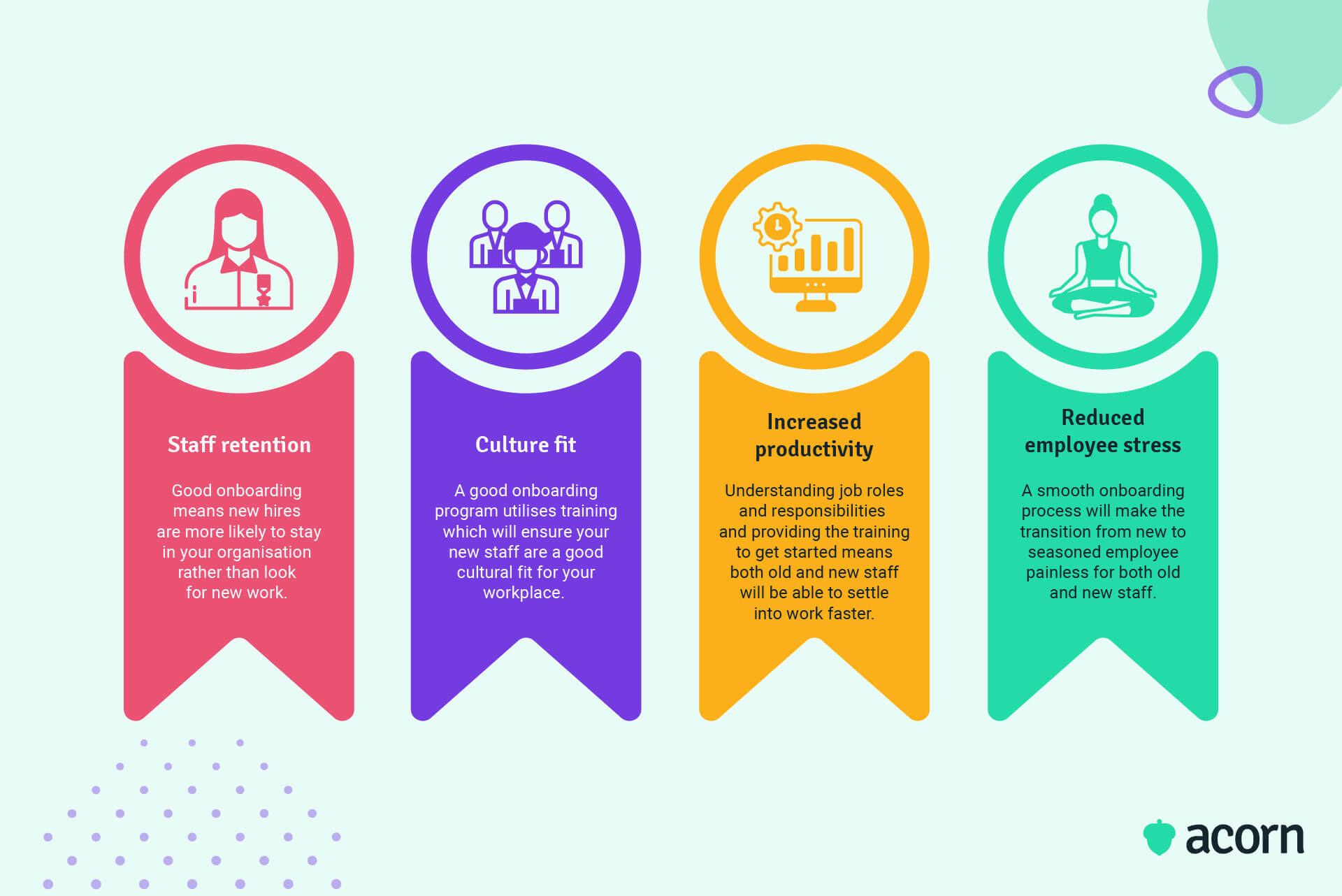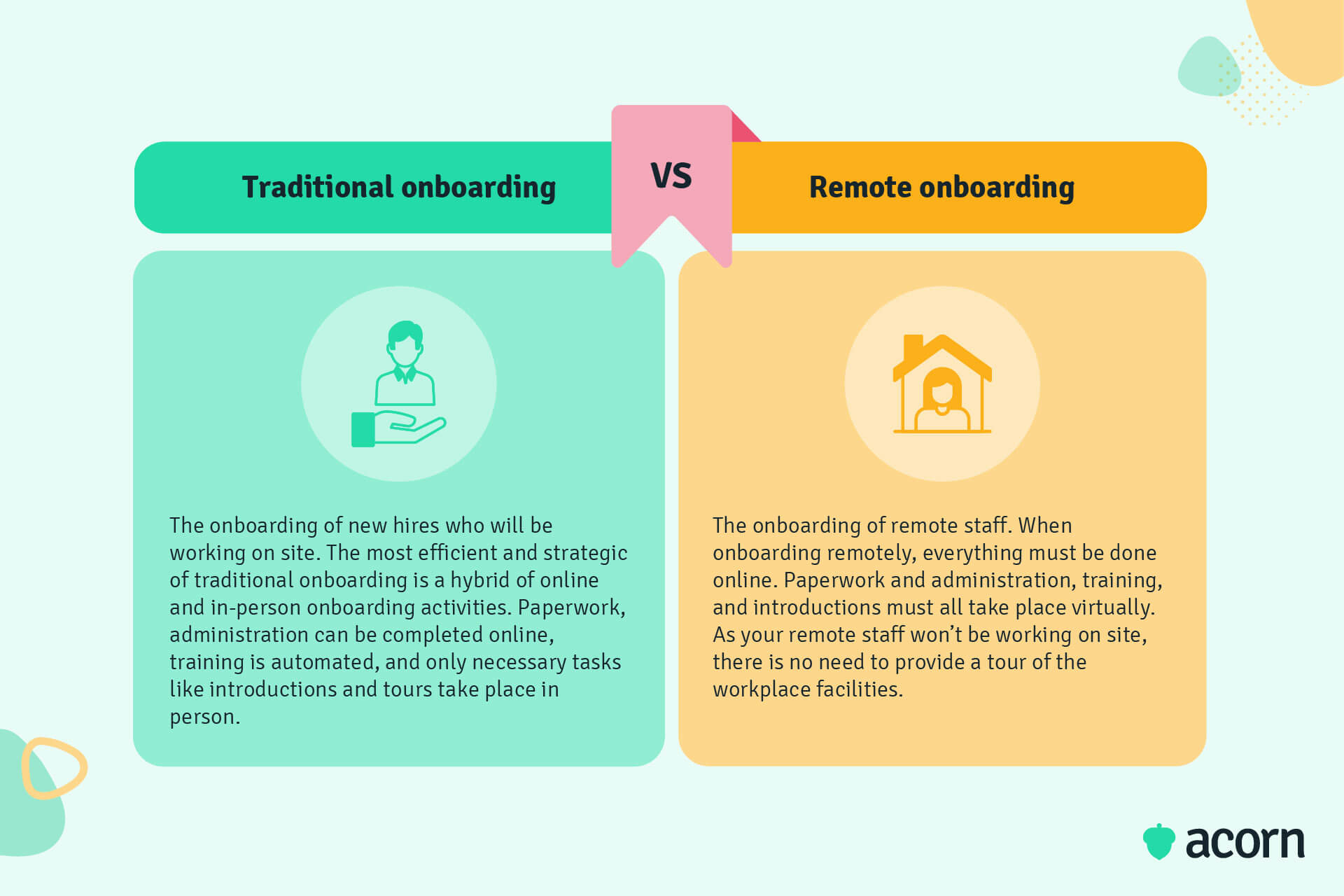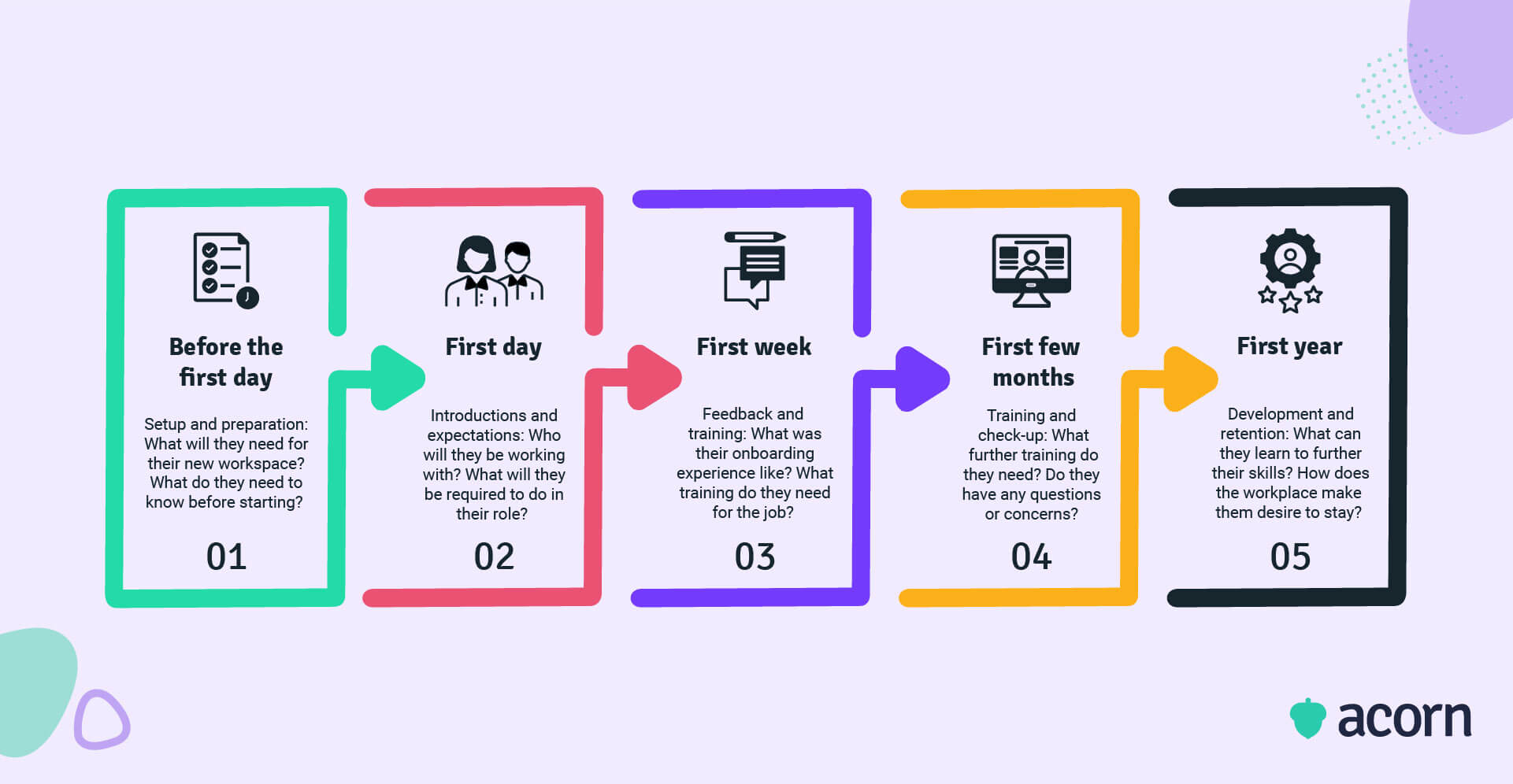What is Employee Onboarding and How Can You Onboard New Staff Effectively?
Reading Time:

Lead the pack with the latest in strategic L&D every month— straight to your inbox.
SubscribeOnboarding is the process of transitioning new candidates into fully-fledged employees, but a bad onboarding experience can set you back eons.
You’ve found the right person to fill the job gap in your business and now it’s time to begin onboarding them for a fast start. Bringing in new talent to your workforce sounds like a simple enough task, but it can actually be quite complicated.
There are a lot of tasks, small and large, that need to be completed before, during and after your new employee’s start. If you want to bring in new people efficiently, you’ll want to know the best strategic process for onboarding new talent to your organisation in a positive and effective way.
What is employee onboarding?
Employee onboarding is the process of introducing new employees into your business. It’s the practice of welcoming new recruits and providing them with guidance, training, and support in their transition from new candidate to full-fledged employee. The whole process from beginning to end can last anywhere between 3-12 months.
Why is onboarding important?
Some organisations make the onboarding process all about administration: Signing paperwork and employee documents, getting set up with new emails and accounts, and granting access to required software. The problem with this kind of onboarding practice is that it’s such an impersonal process, and that can leave your new hire with a bad taste in their mouth.
This is why here at Acorn, we’ve pioneered the first performance learning management system (PLMS) to guide learners step-by-step to master the role-specific capabilities that will accelerate organisational performance (and new hires’ time to proficiency).
If you want to avoid going through the hiring process every few months, or don’t want to foster a disorganised or resentful workplace, you’ll want to ensure your onboarding program is as smooth and painless as possible. That means you need to take the time to refine your onboarding strategy. Some benefits of a refined and positive onboarding experience are:
- Staff retention
- Culture fit
- Increased productivity
- Reduced employee stress.

Staff retention
Staff retention is all about keeping your current workers from jumping ship to another company—and it starts with onboarding.
A negative onboarding experience can make employees feel unwelcomed at best and like they made a mistake and should look elsewhere for work at worst. Studies suggest that 90% of employees decide whether to stay or leave a workplace within the first six months of starting a new role. Essentially: the first impression really does matter.
Culture fit
If onboarding is successful and new employees feel like they belong in your workplace, they’re more likely to want to stay. Ensuring new candidates are a culture fit for your workplace is incredibly important, but it can also be difficult to guarantee. It’s unrealistic to expect new employees to acclimate from the moment they arrive, so part of the onboarding process should be dedicated to training them in company culture.
Increased productivity
On the topic of culture, studies show that long-term productivity increases in businesses with a healthy workplace culture. And while productivity might not be something you think of in the same breath as onboarding, a good onboarding experience has been found to increase productivity in new recruits. If you make it clear in your onboarding process what the new employee’s role entails and clearly outline what is expected of them, your new employees will find it that much easier to perform their role.
Reduced employee stress
Structure is key for onboarding, for both current employees and new hires. Having resources, milestones, and tools ready to go ensures that existing team members are not running the whole show, only facilitating a smooth introduction to culture and work. Consider using a workflow tool like Momentum to define the ideal milestones for new hires and automate process flow (i.e., when a new hire has completed one part of their onboarding module, their manager is notified, and the new hire is given access to the next module). This ensures the tedious elements of onboarding are automated and out of mind, so managers and teammates can gain back time to focus on the cultural aspects.
Remote onboarding
Following the global pandemic, there’s been a major shift to hybrid work models. But that can mean many employees have a virtual onboarding experience, which can change the stakes.
Think about your first day at a new job. It’s more than likely you were feeling nervous, unsure, or doubtful. If you were onboarding in person, some fears may be dispelled by familiarising yourself with the office and team. But when onboarding remotely, there isn’t a mentor to meet you at the door, offer you guidance in person, or provide relationship-building opportunities with the rest of the team.
Lacking that face-to-face personal touch, it’s important to make sure your remote onboarding process is just as positive and effective as your traditional onboarding process.
Here’s our quick guide:
- Pre-onboarding: Send an email with a welcome pack that includes a start date, schedule, and list of initial tasks. Set up all their software and send any hardware to them with plenty of time before their start date. Hot tip: Include hard copies of their welcome pack with their equipment!
- First day: Set up a video call with the team early on. You can roll that into an orientation session on company culture, mission, values, and organisational structure, as well as a tech walkthrough.
- First week: Have a training plan ready-to-go that includes self-paced learning, virtual training sessions, and hands-on projects. Give them a buddy in their team for quick-fix support. We recommend setting up calls with key players in other teams so the new hire gets a lay of the land; e.g. introduce a new marketing manager to the product lead.
- First month: Regular check-ins between employee and their managers should focus on thoughts and feelings over performance for the first month. This way, managers build trust while demonstrating the company invests in employee wellbeing. It’s also a chance to create a feedback loop on the onboarding process itself. (Work smarter and optimise as you go!)
- Two months onwards: Start setting performance goals for new hires and get them set up in your L&D cycle. Give them a project of their own for a small-term win, and start to phase one-on-ones to focus on performance development.
Another hot tip: Set up times for informal team bonding outside of regular meetings, too. That could be a 30-minute team coffee chat a couple of mornings each week or an hour-long virtual drinks session after work. Encouraging new hires to get to know their teammates on a personal level helps bridge the culture gap that virtual environments can sometimes cause.

How to create an effective onboarding process
Just like a pair of jeans, there’s no one-size-fits-all onboarding program. However, you can still build the bones of a program that can be dressed up and down for different needs in your organisation.
What an onboarding process should cover
If you want your onboarding procedures to have any measure of success, there are certain activities to include in the process. For example:
- Paperwork and administration
- Workplace tour
- Policy and culture training
- Job training
- Team introduction.
Paperwork and administration
This is probably what most people think of when they think of onboarding. Paperwork includes employee documents such as contracts, payment details, responsibilities, and benefits. On the administrative side, tasks include preparing accounts and passwords and allowing access to the necessary software.
While unavoidable, it’s best to get paperwork out of the way before the first day. Get new hires to complete their documents ready for their first day, and ensure that your IT admin or the team manager has their laptop set up and ready to go so they can hit the ground running.
Workplace tour
The classic guided tour of the workplace should be top of the list on the first day. It’s not just about knowing where the bathrooms are; they should be made aware of where the exits and emergency exits are, where they can find key stakeholders, and how to access extra resources like notepads, pens, and the like.
Bonus: if there are cafes and shops close by, take them out on a coffee run and show them the local spots.
Policy and culture training
If you’re recruiting using capabilities, then you’ll be hiring people who already have the desired behaviours for your culture. Reinforcing those through policy training helps new hires understand organisational processes and how to apply them. Training can be automated to free up time and effort for other activities in the onboarding process.
Job training
Day-one development plans show new hires how they can progress in your organisation. Using the capabilities of their job roles, you can assign assessments in their first week to baseline proficiency and immediately offer relevant learning content. Acorn’s capability mapping functionality enables you to have content pre-mapped to capabilities and proficiency levels so that development plans are instantly created when an employee completes an assessment.
Team introduction
The first port of call should always be to break the ice and build rapport with new hires. It can be handy to provide a rundown of names and roles before the first day or as part of your onboarding module, particularly in small to medium-sized companies. Follow up with a face-to-face introduction when the new employee starts, so that they can put names to faces. If budget allows, set up a bonding session for a team in the first week so employees can get to know each other outside the remit of work.
What does an ideal onboarding timeline look like?
Knowing what the employee onboarding process should cover, the next question is how long should onboarding last? Again, there’s no magic timeframe. If anything, it’s about setting goals at the most impactful moment in time for new hires to feel their impact.

Before the first day
New hire onboarding actually begins when they accept your job offer, long before your new employee actually arrives for their first day. After going through recruitment procedures and choosing your desired candidate to fill the role, there are some things you’ll need to prepare to make the first day run as smoothly as possible.
One of the easiest ways to achieve this is to let your employees—both current and incoming—know what is happening. Inform your team when to expect the new recruit, what their role will be, and how they can help during onboarding. You should also send your new recruit an email at least a week before their first day to let them know you’re excited to be working with them as well as include important information.
- Paperwork: Make your onboarding process more efficient by providing employment paperwork before the first day. This way they can sign the necessary documents electronically, freeing up the first day for other tasks.
- First-day details: You can help ease the overwhelming feeling of the first day by letting them know what time they should arrive, where they should go, and what is scheduled for the day.
- Buddy introduction: Assign a mentor and have them introduce themselves to your new hire. A mentor’s job is to help guide new employees through the onboarding process, providing guidance and advice. This is an important and beneficial task, especially in remote onboarding. It’s a great way to make the new environment welcoming and comfortable for newcomers.
- Equipment preferences: Ask if your new hire has any preferences regarding their work equipment, such as standing desks, a left-handed mouse, or uniform size. Knowing this means you can have the equipment ready for your new recruit’s first day.
- Employee handbook: Provide them with a handbook including information about the organisation, its history, workplace culture, and the team. (Bonus points if it’s a module you can provide scalable access to.) It’s also a good idea to set up the new hire’s required accounts and provide their passwords in the packet.
- Equipment setup: If you’re remote onboarding, it can be helpful to have a session with new hires before their first day to set up their equipment and technology. You can send them the necessary laptops, phones, or other devices prior to their first day to help ease that first-day anxiety.
First day
Now that you’ve completed a number of tasks beforehand, you’ll probably find that your new employee’s first day is a lot less stressful. What’s more, there will be more time to complete other onboarding tasks which otherwise would have been pushed back to later in the week.
The most important things to cover on the first day are introductions and expectations. Keep it light, if possible, and focus on welcoming new people into your existing team culture.
There are a few activities you can do to help with this.
- Team introduction: You already gave a quick overview of who your new recruit would be working with in the information packet, but they can’t put names to faces yet. Organise a meeting so the team can introduce themselves in person.
- Arrange for a coffee or lunch: On the company. It will help to break the ice and allow both the new employee and the team to get to know each other, making for better working relationships.
- Training: Start new hires with training on their role, covering basic duties and job responsibilities, company procedures, culture, and health and safety policies.
First week
While autonomy is likely the end goal, prepare for hand-holding in the first week. Their assigned mentor or buddy should be someone on their team or easily accessible in person or via message. Beyond that, there are a few other goals.
- Check-in: At the end of the first week, you should be sure to have a check-in with the new employee. This will be a great opportunity to get feedback on the early stage of their onboarding while it’s still fresh in their mind, allow them to pose any questions they may have on the role or the company, and continue to build rapport between managers and employees.
- Training: Training should continue, whether that’s your onboarding module or their new development plan. Start them on tasks that give them easy wins, but aren’t necessarily low stakes. Depending on the role, getting new hires working on big or complex projects will give them insight into the ongoing operations of your company.
- Cross-team meetings: As previously mentioned, arrange meetings between new hires and key players on other teams they’ll need to work with. It can also help to get them across other business functions and their remits, so they have better business context.
First three months
The dust (ahem, nerves) will settle in the first three months and new employees should start to feel, well, no longer new. This means that not only can their mentor take a step back, but they will start to carry out their tasks and responsibilities independently.
- Check-in: Keep checking in weekly with your new employee, and start to pepper in performance conversations with the vibe checks. You can expect more autonomy in their day-to-day work, but make sure their buddy is still on call for assistance.
- Goals: The first of the big goals employees set should be ticked off around now. Take stock of how they found the journey to achieve them, and reset new goals for them in the next three, six, and 12 months. The new goals can also be more directly related to career progression in your organisation, given they’ll have more context.
- Keep notes: Make sure you keep track of how your onboarding process is going. What have you changed during the program to get it working? Not only will it help with the effectiveness of your current onboarding process, but it will provide a framework for when you next have to carry out onboarding.
First year
Now that your new employee has been in your organisation for a year, you can switch your strategy from onboarding to retention. Celebrate this milestone with an organisation-wide announcement or team lunch. (Never underestimate the value of recognition.) Reset goals again; what role might the employee want to progress into? Is there different work they’re interested in taking on? What are the pathways to get there?
By this point, you’ve likely collected a good amount of feedback on how your onboarding program went. Keep tweaking your process, whether at the team or organisation level, to provide the best start for new hires. Remember that onboarding is just as much about creating a good impression of you as it is the new hire showing their value. Feedback is a two-way street, after all.
Key takeaways
The onboarding process is an extensive undertaking, but it pays well. When you find the right person to fill the right role in your organisation, it goes without saying that you want them to stay for the long haul. An effective and positive onboarding process, whether in-person or remote, is an easy and sure-fire way to make your employees, both old and new, feel welcome and valued in your workplace.